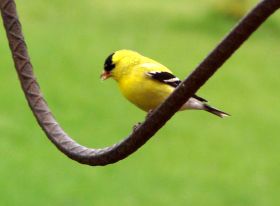 The songbird nesting season is winding down and many have stopped singing, but yesterday one bird caught my attention. Singing loudly and flying high, American goldfinches are ready to nest.
The songbird nesting season is winding down and many have stopped singing, but yesterday one bird caught my attention. Singing loudly and flying high, American goldfinches are ready to nest.
Goldfinches are confirmed seed eaters. Unlike other songbirds, they don’t feed insects to their young. Instead they wait for the seeds to ripen, then they assess the crop to choose a site where food is plentiful. This means they nest in July in Pittsburgh.
After they’ve paired up, the male claims his territory with a beautiful canary-like song while he slowly flutters in a wide circle above the trees. He also sings “perchicoree” in an exaggerated roller-coaster flight.
Meanwhile the female builds her nest in a secret hiding place. After she lays her eggs she spends 95% of her time incubating. She doesn’t even stop to eat. Instead, her mate collects and swallows seeds, then flies his display above her. If she’s hungry, she calls to him from the nest with a soft “teeteeteeteeteeteetee” sound. He then flies down and feeds her the partially digested seed.
Last summer Karen Lang and I discovered a goldfinch nest near Heinz Chapel on Pitt’s campus. We saw all the displays I mentioned above – right down to the male feeding his mate – but I didn’t know what I was seeing. This year I know what to look for. How happy it made me to see Mr. Goldfinch warbling above the trees at home.
It’s Goldfinch Time!
(photo by Marcy Cunkelman)
Thanks for the info. That explains why I suddenly have 2 male goldfinches eating at my backyard thistle seed feeder constantly, where I’d only see them occasionally before.
On the commute in to work last week, we saw a male goldfinch feeding on the roadside thistle plants on Frankstown Road. He made a gorgeous contrast against the green and purple – I only wish I’d had my camera.
Hello, Kate.
I’d not read your blog for a couple of weeks, as is my habit — I like to “stockpile” the entries, then read thru. The timing for me to have read in today from the 10Jul entry was perfect, per my short anecdote, below.
I, too, had noticed goldfinches in the last week or so. I was becoming concerned for having not seen them till then; didn’t occur to me that their arrival is “timed” for the sunflower seeds, etc.
They’re such striking birds in a city environment; seems now that every other sidewalk strip or front-yard garden might have a goldfinch exploding forth from the sunflowers or hollyhocks. What fun to watch their undulating flight!
Thanks for the mini-lesson.
David
i never knew why we have so many many more males at my feeders in the early summer..
i guess the females are busy this time of year.how sweet the male feeds them and a good thing or theyd surely starve before the eggs hatch out..
we set up niger seed feeders special for these beautiful birds and have shown alot of people we know about them and show them what feeders to use to attract them.
I lived in Pgh 32 yrs before I even knew we had them I just happened to see them eating from m y garden plants and when i tried a feeder sock w niger seed i suddenly had a hundred..
my father saw them in my yard a few years ago and says they had these in Library Pa where he grew up as a child and they called them wild canarys.. he also never knew that they also live right here in the city and that if you provide a feeder w niger seed or the proper plantings that these will never leave your yard here in pgh…